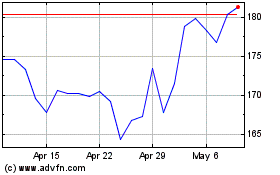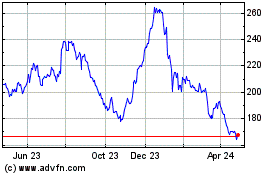By Andy Pasztor and Andrew Tangel
LE BOURGET, France -- Efforts to get Boeing Co.'s 737 MAX
jetliners back in the air have been delayed in part by concerns
about whether the average pilot has enough physical strength to
turn a mechanical crank in extreme emergencies.
The concerns have made the crank -- which moves a horizontal
panel on the plane's tail -- the focus of engineering analysis,
simulator sessions and flight testing by the plane maker and U.S.
air-safety officials, according to people familiar with the
details. The extent of the internal debate hasn't been previously
reported.
Use of the crank is intended as the final step in an emergency
checklist to counteract dangerous movements of the tail's
horizontal stabilizer, such as those involved in two fatal crashes
of MAX aircraft when an automated flight-control system
malfunctioned.
Turning the crank to adjust the horizontal stabilizer can help
change the angle of the plane's nose. Under certain conditions,
including at unusually high speeds with the panel already at a
steep angle, moving the crank can take a lot of force. Among other
things, the people familiar with the details said, regulators are
concerned about whether female aviators -- who typically have less
upper-body strength than their male counterparts -- may find it
difficult to turn the crank in an emergency.
The analysis could have even wider significance because the same
emergency procedure applies to the generation of the jetliner that
preceded the MAX, known as the 737 NG. About 6,300 of these planes
are used by more than 150 airlines globally and they are the
backbone of short- and medium-range fleets for many carriers.
Neither Boeing nor regulators anticipate design or equipment
changes to result from the review, these people said. But the issue
has forced a reassessment of some safety assumptions for all 737
models, as previously reported by The Wall Street Journal.
The global MAX fleet of about 400 planes was grounded in March,
following two fatal nose-dives triggered by the misfiring of an
automated flight-control system called MCAS. The two crashes killed
a total of 346 people.
There are no plans to restrict certain pilots from getting
behind the controls of any 737 models based on their strength,
according to people with knowledge of the deliberations. But both
Boeing and Federal Aviation Administration leaders are concerned
that if discussions of the matter become public they could be
overblown or sensationalized, according to industry and government
officials familiar with the process.
All underlying safety questions about the 737 MAX have to be
resolved before the FAA can put the grounded fleet back in the air,
according to U.S. and European aviation officials.
In response to questions, a Boeing spokesman said: "We will
provide the FAA and the global regulators whatever information they
need." Previously, Boeing said it is providing additional
information about "how pilots interact with the airplane controls
and displays in different flight scenarios."
Speaking before the Paris Air Show here this week, Boeing Chief
Executive Dennis Muilenburg said he wanted to conduct an
"end-to-end, comprehensive review of our design and certification
processes," as well as other matters.
An FAA spokesman declined to comment on specifics. Acting FAA
chief Daniel Elwell has said the agency is pursuing a complete
investigation of the two MAX crashes, including examination of
emergency procedures, training and maintenance.
FAA experts also aim to study how issues regarding pilot
strength were dealt with during certification approvals of older
versions of the 737, according to the people familiar with the
specifics.
Simulator sessions and flight tests have measured the strength
required to turn the crank in various flight conditions for pilots
of both genders, according to two of the people briefed on the
details.
In a flight-simulator test earlier this month, Journal columnist
Scott McCartney and pilot Roddy Guthrie, fleet captain for the 737
at American Airlines, experienced troubles in turning the wheel. As
described in a June 5 article, Capt. Guthrie couldn't move the
wheel until Mr. McCartney pitched the plane's nose down, easing
some of the pressure on the wheel. See how the wheel works in this
WSJ visual about the two crashes.
Government and industry experts are considering possible
operational, training and pilot-manual changes to resolve safety
concerns about the procedure, according to the people familiar with
the specifics. The results are expected to be part of a package of
revised software and training mandates that the FAA is seen issuing
later this summer.
Capt. Chesley "Sully" Sullenberger, the retired US Airways pilot
celebrated for his 2009 "Miracle on the Hudson" landing, said
Wednesday that pilots should be required to spend time in
simulators before the MAX returns to service, not only to review
the updates to the MCAS software but to practice situations where
manually turning the crank would be more challenging. At higher
airspeeds, turning the wheel could require two hands, the efforts
of both pilots, or may not even be possible, he said.
"They need to develop a muscle memory of their experiences so
that it will be immediately accessible to them in the future, even
years from now, when they experience such a crisis," he said
Wednesday at a hearing of the House Committee on Transportation and
Infrastructure's aviation subcommittee.
Mr. Sullenberger told the committee that he recently experienced
a recreation of the fatal MAX flights in a flight simulator. He
came away from it understanding how crews could have been
overwhelmed by alerts and warnings without enough time to fix the
problem.
The former commercial pilot also expressed broader concern about
how the MAX was designed and certified by regulators. "It is clear
that the original version of MCAS was fatally flawed and should
never have been approved," Mr. Sullenberger said in written
testimony.
"The 737 MAX was certified in accordance with the identical FAA
requirements and processes that have governed certification of
previous new airplanes and derivatives," a Boeing spokesman said in
a statement. He also said the company continues to work on training
requirements with global regulators and airlines.
The pending software fix is intended to make it easier for
pilots to override MCAS, which moves the horizontal stabilizer to
point the nose down.
The FAA's testing comes after the agency prodded Boeing to draft
a new safety assessment covering MCAS as well as the related
emergency procedure, according to U.S. and European aviation
officials.
The FAA isn't alone in documenting the differences in average
strength between men and women in critical safety roles. The
Pentagon, for example, categorizes such information in assessing
the fitness of some uniformed personnel for certain
assignments.
--Alison Sider contributed to this article.
Write to Andy Pasztor at andy.pasztor@wsj.com and Andrew Tangel
at Andrew.Tangel@wsj.com
(END) Dow Jones Newswires
June 19, 2019 18:32 ET (22:32 GMT)
Copyright (c) 2019 Dow Jones & Company, Inc.
Boeing (NYSE:BA)
Historical Stock Chart
From Mar 2024 to Apr 2024

Boeing (NYSE:BA)
Historical Stock Chart
From Apr 2023 to Apr 2024
